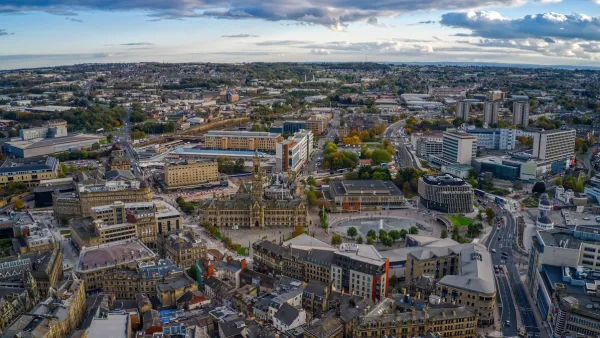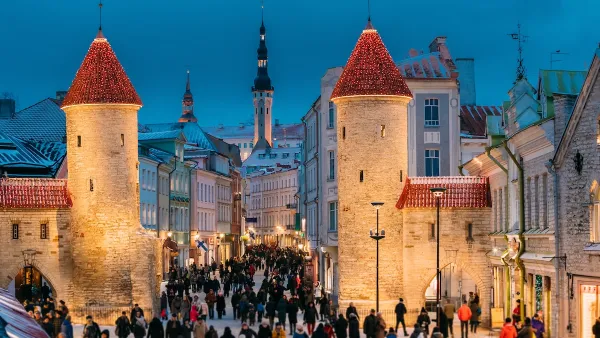The built environment is a significant contributor to community health – a fact that researchers, planners, public health practitioners, and advocates around the country are becoming increasingly aware of. We know, for example, that people who live in more “walkable” communities are in fact more likely to walk. Research has demonstrated that living near a grocery store increases consumption of fresh fruits and vegetables. Children who live near freeways may suffer from respiratory problems for the rest of their lives. These facts should be particularly important in shaping land use decisions as we face rising costs from the obesity epidemic and other chronic diseases. This leaves public health advocates wondering just how best to dig into the world of planning.
The built environment is a significant contributor to community health – a fact that researchers, planners, public health practitioners, and advocates around the country are becoming increasingly aware of. We know, for example, that people who live in more "walkable" communities are in fact more likely to walk. Research has demonstrated that living near a grocery store increases consumption of fresh fruits and vegetables. Children who live near freeways may suffer from respiratory problems for the rest of their lives. These facts should be particularly important in shaping land use decisions as we face rising costs from the obesity epidemic and other chronic diseases.
This leaves public health advocates wondering just how best to dig into the world of planning. Not only are planning tools and concepts a "foreign language" requiring interdisciplinary training and new ways of looking at community health, but there isn't a clear "one size fits all" method for participation in built environment decision-making processes. In growing communities, like many in California and across the Western United States, public health staff may be faced with proposed master planned developments that will bring thousands of new residents to their communities. In urban and built-out communities, infill development poses its own challenges. The question is: how can public health advocates best contribute to these processes and help ensure that new development maximizes opportunities to improve community health?
One tool that some public health agencies are developing and using is "healthy development checklists." These checklists are designed to provide users with a framework in which to evaluate different elements of a development from a public health perspective. They look at issues like street design, waste water management, and air quality, among others. The National Association of City and County Health Officials developed a Public Health in Land Use Planning and Community Design checklist with the Tri County Health Department (CO). The Shasta County Health Department (CA) has made their own Public Health Development Checklist tailored to their local needs. And a recently-released Healthy Development Measurement Tool (HDMT), created by the San Francisco Department of Public Health – Environmental Health Division suggests a broad spectrum of measurable indicators that health advocates and communities can use to assess how a proposed development might affect health. These indicators cover a wide variety of categories, including Environmental Stewardship, Sustainable and Safe Transportation, Adequate and Healthy Housing, and Community Participation.
Checklists are welcome tools because they allow communities to engage with development in a standardized, replicable way - one that hopefully improves the health outcomes that result from these developments. However, they don't let practitioners off the hook when it comes to the hard work of figuring out what local health issues are most pressing and tailoring checklists to fit local needs. They also don't tell communities what is a "healthy" or "unhealthy" development – a fact that the HDMT makes refreshingly transparent. Development is always about tradeoffs. Choosing to build high-density residential developments next to a freeway might result in negative health impacts for those residents, but could potentially improve regional air quality if regional vehicle miles traveled decrease. This contentious trade-off is discussed in a recent article of the California Planning and Development Review by William Fulton. Both planners and public health practitioners should resist using development checklists as a simple way to say "yes" or "no" to development, and instead see them as a way to make trade-offs more visible, improve proposals, and to engage the community in a discussion about how our communities should grow.

Analysis: Cybertruck Fatality Rate Far Exceeds That of Ford Pinto
The Tesla Cybertruck was recalled seven times last year.

National Parks Layoffs Will Cause Communities to Lose Billions
Thousands of essential park workers were laid off this week, just before the busy spring break season.

Retro-silient?: America’s First “Eco-burb,” The Woodlands Turns 50
A master-planned community north of Houston offers lessons on green infrastructure and resilient design, but falls short of its founder’s lofty affordability and walkability goals.

Test News Post 1
This is a summary

Analysis: Cybertruck Fatality Rate Far Exceeds That of Ford Pinto
The Tesla Cybertruck was recalled seven times last year.

Test News Headline 46
Test for the image on the front page.
Urban Design for Planners 1: Software Tools
This six-course series explores essential urban design concepts using open source software and equips planners with the tools they need to participate fully in the urban design process.
Planning for Universal Design
Learn the tools for implementing Universal Design in planning regulations.
EMC Planning Group, Inc.
Planetizen
Planetizen
Mpact (formerly Rail~Volution)
Great Falls Development Authority, Inc.
HUDs Office of Policy Development and Research
NYU Wagner Graduate School of Public Service





























